The two most common questions customers ask me are, “Are your animals happy?” and “Do you love your animals?” These two questions are so popular I get them almost on a daily basis. I think these questions are really interesting, especially if you step back for a moment and analyze them. Customers want to know that the eggs they are about to buy, the meat they are about to consume or the milk they are about to drink came from animals that were…well… happy and loved. It’s not a bad thing to want. More than ever it seems customers want to know that their food was raised in an ethical, sustainable, and yes, even loving environment. I have had many customers over the years swear they can “taste the happiness” in our products. Surely you could taste sadness…right???
Birthing Center at the New York State Fair
Over the last 100 years, we’ve seen massive shifts in agriculture. One of the greatest shifts has been people leaving the farm for other employment. In the early part of the 20th century, over 30% of the population was involved in farming. Today, that figure is less than 2%. It stands to reason that the general public will know less and less about how their food is raised. But it is knowledge people still crave. To fill the gap, consumers ask questions. Unfortunately, the questions often oversimplify a complex topic, or sometimes miss the mark entirely.
Take, for instance, the question “Are your animals happy?” No farmer would ever ask that of another farmer. If I asked my neighbor Bob if his cows were happy, he’d look at me like I’d flipped my lid. Are they happy? Bob does his best to make sure his girls are comfortable. Comfortable cows give more milk and have fewer health problems. He makes sure they are well-fed. Bob works with a nutritionist who tests his hay and other inputs, looks at his herd’s milk components, body condition, and stage of lactation and recommends a specific ration, depending on Bob’s goals. He makes sure they are healthy. Bob works closely with a veterinarian that visits the farm regularly. She does pregnancy checks, routine vaccinations, and helps assess overall herd health. On any given day, Bob will know if a cow is not feeling well if her ears droop a little or if she lingers at the back of the herd when she is normally the first at the feed trough. Finally, Bob makes sure his girls follow a routine. If he alters that routine too much, they may become belligerent and may even panic. Farmers take great care to make sure their animals remain calm, for everyone’s safety.
Bob and farmers like him everywhere are pretty in tune with their animals, and for good reason. It’s their business. Anyone that has worked in animal agriculture will tell you that if an animal is—for lack of a better word—“unhappy,” it will not perform well. Keeping their animals “happy” is in the farmer’s best interest. Unhappy cows give less milk, unhappy hens lay fewer eggs, unhappy pigs don’t make much bacon.
The tricky word here is “happy.” It’s a great marketing term, but falls short on actually delivering useful information.
“Do farmers love their animals?” is a far easier question to answer; although it is still not a question farmers ask each other. If I asked my girlfriend Angie if she loved her cows, she’d probably give me some smart answer like, “some more than others!” and then quickly add, “Of course I do! Why would you ask me that?!?” Working with animals, every day, 365 days a year, through summer heat and frigid winters, watching them closely for any early signs of a possible problem, caring for their every need over a lifetime, creates a bond like no other. Yes, animals have distinct personalities, and yes, every farmer has her favorites.
But it is a complicated relationship. Farming is first and foremost a business. Angie may love her cows and want to make them comfortable, but she doesn’t have them snoozing on Tempur-Pedic® mattresses. Bob watches for and tries to prevent any health problems, but sometimes a cow will have too many issues and fixing them would be financially prohibitive. Does he keep her or not? None of these decisions are easy. Indeed, it is a constant challenge for farmers to find the right balance between seeing to their animals’ needs and earning an income that will pay the bills.
My daughters and I recently attended the New York State Fair in Syracuse. (Perhaps you were there, too—they had over one million visitors!) One of the things I had to see was the Birthing Center, where six farms had lined up 36 of their cows scheduled to freshen (give birth) over the course of the entire 10 days of the fair. When we entered the arena, I was astounded. The place was full of people—standing room only!—and everyone was eager to see the birth of a calf. Large viewing screens gave those in the back a better view and the entire event was live-streaming on the web. The audience was invited to ask questions, which they did, and a veterinarian gladly answered all of them. The owner of the cow was on hand to speak, too, as were representatives from Cornell University and the New York Animal Agriculture Coalition, who sponsored the event. It was beyond cool! My eyes welled up with tears when I realized that all of this effort—representing a tremendous amount of work and coordination—was to let fairgoers know that farmers do, indeed love their animals. They also do everything in their power to make them happy, and that task is incredibly complex. I hope they got the message!
